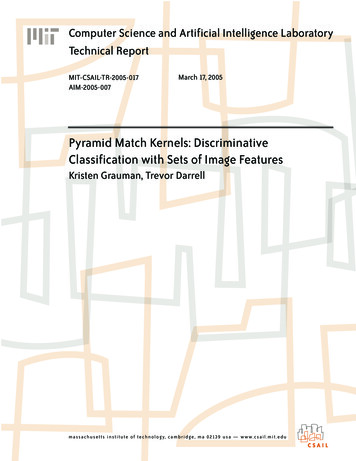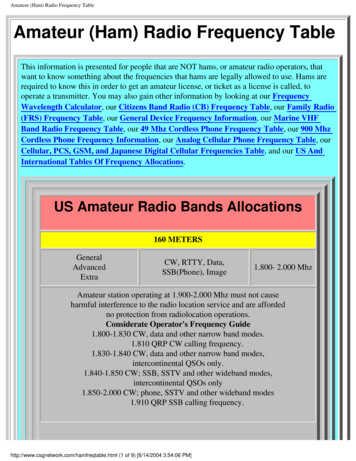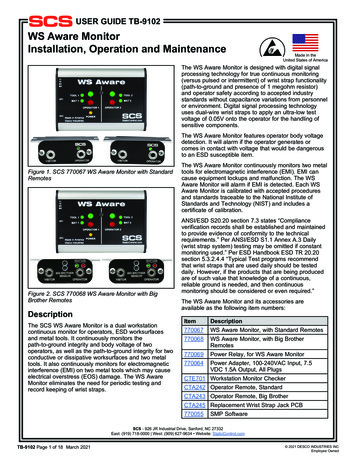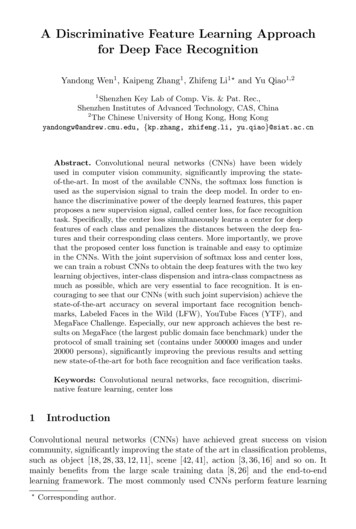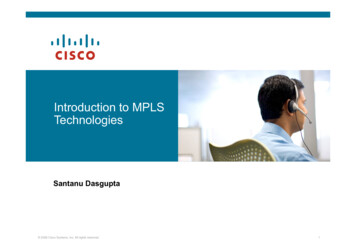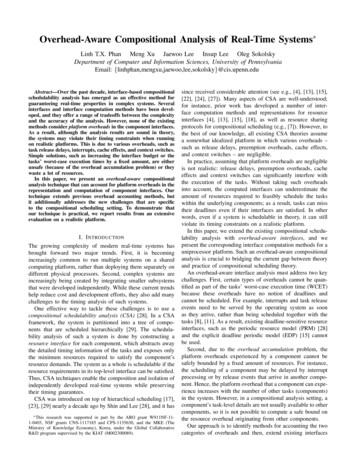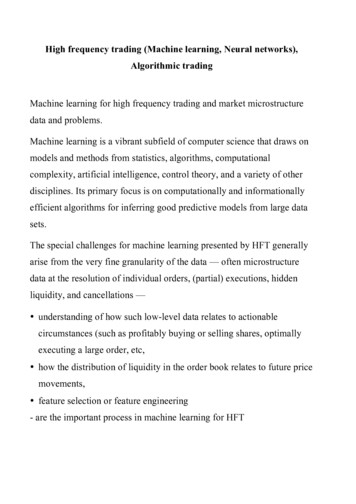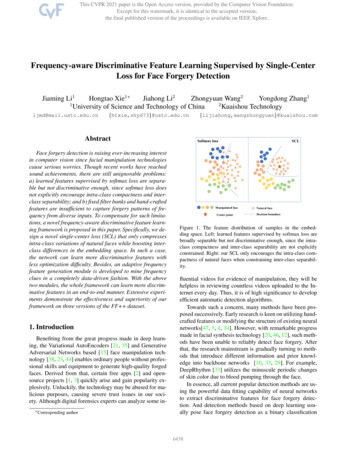
Transcription
Frequency-aware Discriminative Feature Learning Supervised by Single-CenterLoss for Face Forgery DetectionJiaming Li1Hongtao Xie1 Jiahong Li2Zhongyuan Wang2Yongdong Zhang112University of Science and Technology of ChinaKuaishou .edu.cnAbstractFace forgery detection is raising ever-increasing interestin computer vision since facial manipulation technologiescause serious worries. Though recent works have reachedsound achievements, there are still unignorable problems:a) learned features supervised by softmax loss are separable but not discriminative enough, since softmax loss doesnot explicitly encourage intra-class compactness and interclass separability; and b) fixed filter banks and hand-craftedfeatures are insufficient to capture forgery patterns of frequency from diverse inputs. To compensate for such limitations, a novel frequency-aware discriminative feature learning framework is proposed in this paper. Specifically, we design a novel single-center loss (SCL) that only compressesintra-class variations of natural faces while boosting interclass differences in the embedding space. In such a case,the network can learn more discriminative features withless optimization difficulty. Besides, an adaptive frequencyfeature generation module is developed to mine frequencyclues in a completely data-driven fashion. With the abovetwo modules, the whole framework can learn more discriminative features in an end-to-end manner. Extensive experiments demonstrate the effectiveness and superiority of ourframework on three versions of the FF dataset.1. IntroductionBenefiting from the great progress made in deep learning, the Variational AutoEncoders [21, 35] and GenerativeAdversarial Networks based [15] face manipulation technology [38, 23, 44] enables ordinary people without professional skills and equipment to generate high-quality forgedfaces. Derived from that, certain free apps [2] and opensource projects [1, 3] quickly arise and gain popularity explosively. Unluckily, the technology may be abused for malicious purposes, causing severe trust issues in our society. Although digital forensics experts can analyze some in hou.comSoftmax lossManipulated faceCenter pointSCLNatural faceDecision boundaryFigure 1. The feature distribution of samples in the embedding space. Left: learned features supervised by softmax loss arebroadly separable but not discriminative enough, since the intraclass compactness and inter-class separability are not explicitlyconstrained. Right: our SCL only encourages the intra-class compactness of natural faces when constraining inter-class separability.fluential videos for evidence of manipulation, they will behelpless in reviewing countless videos uploaded to the Internet every day. Thus, it is of high significance to developefficient automatic detection algorithms.Towards such a concern, many methods have been proposed successively. Early research is keen on utilizing handcrafted features or modifying the structure of existing neuralnetworks[47, 5, 4, 34]. However, with remarkable progressmade in facial synthesis technology [20, 46, 12], such methods have been unable to reliably detect face forgery. Afterthat, the research mainstream is gradually turning to methods that introduce different information and prior knowledge into backbone networks [10, 33, 29]. For example,DeepRhythm [33] utilizes the minuscule periodic changesof skin color due to blood pumping through the face.In essence, all current popular detection methods are using the powerful data fitting capability of neural networksto extract discriminative features for face forgery detection. And detection methods based on deep learning usually pose face forgery detection as a binary classification6458
problem and use softmax loss1 to supervise the training ofCNN networks. However, learned features supervised bysoftmax loss are not discriminative enough, since softmaxloss does not explicitly encourage intra-class compactnessand inter-class separability, as illustrated in the left of Figure 1. Recent work [22] has noticed this problem and attempted to utilize triplet loss [37] to extract discriminativefeatures. However, regular metric learning methods usuallyindiscriminately encourage the intra-class compactness ofnatural and manipulated faces in the embedding space. Additionally, feature distributions of manipulated faces varyfrom one manipulation method to another considering various GAN fingerprints [48] and some unique operations,as shown in the left of Figure 1, making it nontrivial toaggregate all the manipulated faces. Therefore, constraining intra-class compactness of samples generated by variedmanipulation methods usually leads to a sub-optimal solution because of optimization difficulty and even damagesthe performance owing to overfitting.In addition, frequency-related cues are increasingly important for forgery detection since it’s hard to find visualforgery clues. Although some studies [29, 9, 41, 13] haveintroduced frequency information and achieved remarkableresults, their abilities to extract discriminative features arelimited because of employing fixed filter banks and handcrafted features. These methods based on incomprehensiveprior knowledge are insufficient to capture subtle forgerypatterns from the frequency domain due to the diversity ofbackground, gender, age, manipulation methods, etc.With the above thoughts in mind, we propose a novelFrequency-aware Discriminative Feature Learning framework(FDFL). Explicitly, our framework mainly addressestwo problems: a) how to adopt metric learning to learn morediscriminative features for face forgery detection; and b)how to adaptively extract frequency-related features. Corresponding to the two problems, two sub-modules are developed: single-center loss (SCL) and adaptive frequencyfeature generation module (AFFGM), as shown in Figure 2.In specific, our single-center loss aims at only reducingintra-class variations of natural faces while increasing interclass differences in the embedding space, as shown in theright of Figure 1. To this end, SCL minimizes the distancefrom representations of natural faces to the center point.Meanwhile, SCL encourages the distance from manipulatedfaces to the center point greater than from natural faces byat least a margin. Unlike regular metric learning methods,SCL does not restrict the intra-class compactness of manipulated faces, which agrees better with the characteristicsof feature distribution of manipulated faces. Therefore, thenetwork supervised by SCL can learn more discriminativefeatures with less optimization difficulty. As for frequency1 Following [27], we define the softmax loss as the combination of thelast fully connected layer, softmax function, and cross-entropy loss.related features, we develop an AFFGM consisting of aspecial data preprocessing and adaptive frequency information mining block (AFIMB). The data preprocessing keepsthe position relationship of image blocks in the spatial domain consistent with their position relationship in the frequency domain. In such a case, the preprocessed data is ableto directly employ the existing convolution network. TheAFIMB adaptively mines frequency clues in a data-drivenfashion, which avoids utilizing too much incomprehensiveprior knowledge. Compared to fixed filter banks and handcrafted features, AFFGM can capture forgery clues moreflexibly in the frequency domain.Extensive experiments demonstrate the effectiveness andsuperiority of our framework and we achieve state-of-theart results on three versions of the FF dataset [36]. Ourcontributions can be summarized as follows: We propose a novel Frequency-aware discriminativefeature learning framework which adopts metric learning and adaptive frequency features learning for faceforgery detection. A single-center loss is designed to only compress intraclass variations of natural faces while boosting interclass differences in the embedding space. An adaptive frequency feature generation module isdeveloped to mine subtle artifacts from the frequencydomain in a data-driven fashion.2. Related workWith the development of neural networks and computergraphics, a new generation of face manipulation technologybased on the Variational AutoEncoders [21, 35] and Generative Adversarial Networks [15] has been widely used. Correspondingly, face forgery detection has gradually becomea research hotspot. In this section, we will briefly reviewprevious works.Face forgery detection Early works focus on utilizinghand-crafted features or modifying the structure of existing neural networks [47, 5, 19, 4, 34] to detect face forgery.Yang et al. [47] utilize the inconsistency of the head poseestimated from the central face and the whole face to identify manipulated faces. MesoNet [4] designs a shallow neural network that consists of two inception modules andtwo classic convolution layers. Though sound performanceswere achieved at that time, those methods are incapable ofreliably detecting face forgery now due to the rapid development of face forgery technology. Especially when powerful general feature extractors like xception [7] are appliedto forgery detection, the performance of early works is evenmore unsatisfactory. Therefore, the research mainstream isgradually turning to approaches which introduce different6459
FusionmoduleManipulated facepushNatural facepullSCLCenter pointFeature embeddingRGB branchSoftmax atapreprocessinglinearMax poolingmultiplyFigure 2. The Frequency-aware Discriminative Features Learning framework. AFFGM stands for the adaptive frequency feature generationmodule. AFIMB represents the adaptive frequency information mining block. FC represents the fully connected layer and Lce representsthe cross-entropy loss. The whole framework is trained end-to-end under the joint supervision of SCL and softmax loss.information and prior knowledge into the backbone network to detect face forgery [10, 33, 29]. Dang et al. [10]introduce location information of manipulated regions toguide the network to focus on key regions. Qi et al. [33]exploit bioinformatics that skin color will present minuscule changes periodically due to blood pumping through theface. Face X-ray [24] innovatively uses self-generated datato train the network to locate blending boundaries, whichgreatly improves the generalization ability. Two-branch [29]utilizes fixed filter banks to extract frequency information,which limits the ability to extract discriminative features.In our work, we exploit a simple and effective module toadaptively mine frequency clues.Metric learning Although metric learning has shownits advantages in face recognition [37] and person reidentification (re-ID) [17], learning discriminative featureswith deep metric learning for face forgery detection is moreor less neglected. Center loss [43] and triplet loss [37] arethe two most relevant metric learning methods to our work.Center loss [43] is designed to learn a center for featuresof each class and drive features of the same class closer totheir corresponding center. Obviously, one disadvantage ofcenter loss is that it ignores inter-class separability. Tripletloss [37] encourages features of data points with the sameidentity to get closer than those with different identities.However, triplet loss may suffer from the problem of timeconsuming mining of hard triplets and dramatic data expansion. Kumar et al. [22] utilizes the network with the supervision of triplet loss to detect face forgery. But tripletloss performs poorly on the imagenet pre-trained backbone.Two-branch [29] proposes a novel loss which compressesthe variability of natural faces and pushes away the manipulated faces. But its motivation comes from anomaly de-tection and the approach is very different from our SCL inmany aspects. For example, our center point is updatable,while the center point of the two-branch is fixed. Additionally, two-branch constrains the absolute distance from allsamples to the center point, whereas our SCL constrains therelative distance between natural and manipulated samplesto the center point.3. Proposed method3.1. OverviewAiming at solving the problems of previous methodsin discriminative feature learning and frequency information mining, we propose a frequency-aware discriminativefeature learning framework. As illustrated in Figure 2, ourframework extracts features from the RGB domain and frequency domain at the same time and merges them in theearly stage of the entire framework. After going through afeature embedding, high-level representations are obtained.At the end of the framework is a classifier that outputsthe prediction results of input samples. The mining of frequency clues is achieved by our AFFGM (see Sec. 3.2). Wefuse the frequency domain features and RGB domain features with a simple point-wise convolution block, whichcontributes to the reduction of parameters and computational expense. Finally, with the joint supervision of oursingle-center loss (see Sec. 3.3) and softmax loss, the network learns an embedding space where natural faces areclustered around the center point, while manipulated onesare far away from the center point.3.2. Adaptive frequency features generation moduleWith the success in synthesizing realistic faces, it’sharder to find visual forgery clues. But the discrepancy be-6460
YNaturalCbForgery cuesCrManipulatedRGB to YCbCrDCT transformDCT reshapeDCT concatenateFigure 4. The pipeline of data preprocessing of AFFGM.Figure 3. Inconsistency in the frequency domain could serve as animportant forgery cue. The visualization of energy distribution ina certain frequency band is shown in the right column.tween natural and manipulated faces in the frequency domain, especially in middle and high frequency bands, ispretty apparent as illustrated in Figure 3. Previous studiesmostly use fixed filter banks or hand-crafted methods fromother fields to extract frequency information [9, 13, 41, 29].However, considering the diversity of background, gender,age, skin color, and especially manipulation methods, thesemethods based on incomprehensive prior knowledge are insufficient to capture forgery patterns of frequency. In orderto tackle this problem, inspired by [16, 45, 31, 26, 42], wepropose an adaptive frequency feature generation module(AFFGM) to efficiently mine subtle artifacts from the frequency domain. Our AFFGM consists of two parts: datapreprocessing and adaptive frequency information miningblock. Next, we will introduce them respectively.Data preprocessing The pipeline of data preprocessing isshown in Figure 4. First, input RGB images are transformedinto YCbCr color space. Next, the 2D DCT transformationis applied to each 8 8 block of images. It’s worth notingthat the two steps above are also widely used in current popular image compression standards, e.g., JPEG. We think thatwill contribute to forgery detection from two aspects. Onthe one hand, the acceleration tools of existing compressionalgorithms can help improve the computational efficiencyof our preprocessing. On the other hand, it will make ourmethod more compatible with traces caused by compression. After that, the DCT-transformed coefficients from thesame frequency band in all 8 8 blocks are grouped intoa channel with their original position relationship retained.Therefore, the transformed images can directly exploit existing neural networks. Finally, all frequency channels areconcatenated together to form one tensor. The shape of input images will change before and after preprocessing. Suppose the shape of the original input image is H W 3, thenthe shape of the input tensor becomes H/8 W/8 192after data preprocessing. Moreover, most energy of transformed images is concentrated on the low-frequency bandswhile the middle-frequency and high-frequency bands playmore significant roles in forgery detection. Therefore, everyfrequency channel is normalized by the mean and variancecalculated from the training dataset.Adaptive frequency information mining block Unlikeprevious methods, our AFFGM learns the frequency feature in a data-driven way, which avoids overly dependingon incomprehensive prior knowledge. As illustrated in Figure 2, we empirically design a simple and effective networkblock to extract frequency features. In specific, the preprocessed data first passes through a layer of 3 3 convolutionblock with three groups[18]. That means the data from different channels of Y, Cb, Cr is processed separately. Then,it goes through an ordinary 3 3 convolution block anda max-pooling layer successively. In that process, information from different channels of Y, Cb, Cr interacts with eachother. After that, we employ a channel attention block whichconsists of the aforementioned max-pooling layer and twolinear layers for the sake of feature enhancement. Finally, anordinary 1 1 convolution layer is used to further extractfrequency-related features.3.3. Single-center lossCurrent face forgery detection methods based on deeplearning usually use softmax loss to supervise networktraining. However, the learned features supervised by softmax loss are essentially not discriminative enough, sincesoftmax loss only focuses on finding a decision boundary to separate different classes. The intra-class compactness and inter-class separability are not explicitly considered. Obviously, deep metric learning is a promising solution. However, most metric learning methods, such as tripletloss [37] and center loss [43], usually indiscriminately compress intra-class variations of natural and manipulated facesin embedding space. While feature distributions of manipulated faces vary from one manipulation method to another. That is because GAN fingerprints [48], manipulatedregion, and other unique operations, e.g., post-processingtechniques, lead to specific artifacts for each manipulationmethod. For example, Deepfakes [1] generates the wholeface while NeuralTextures [39] only manipulates the mouth6461
region of the target person. Intuitively, their distribution inthe embedding space should be evidently different. A sideevidence would be that the generalization ability of featureslearned by supervised learning is significantly weakenedon unseen manipulation methods. This implies that featureslearned by supervised learning are highly related to manipulation methods. The feature differences of samples generated by different manipulation methods make it difficult toaggregate all the manipulated faces. Therefore, indiscriminately constraining intra-class compactness in embeddingspace usually leads to a sub-optimal solution due to optimization difficulty and even damages the performance owing to overfitting. In order to solve this problem, we devisea novel single-center loss.Definition As Figure 2 indicates that the goal of SCL isto minimize the distance from the representations of natural faces to the center point and to simultaneously push therepresentations of manipulated ones away from the centerNpoint. Let the given training dataset (xi , y i )i 1 consist ofN samples xi X with the associated labels yi {0, 1}.And these samples are embedded into D-dimensional vectors with a neural network denoted by fθ (·). In our SCL, wejust set the center point C of natural faces. For simplicity,we adopt fi to represent f (xi ) in the following paper. Similar to center loss, our method updates the parametric centersC at each iteration based on a mini-batch. Given a batch oftraining data, we define SCL as: Lsc Mnat max(Mnat Mman m D, 0) (1)where Mnat represents the mean Euclidean distance between representations of natural faces and the center pointC in a batch. And Mman represents the mean Euclideandistance between representations of manipulated faces andcenter point C. Their functions are denoted as:Mnat Mman 1 Ωnat 1 Ωman Xi ΩnatXk fi C k2i Ωmank f i C k2are s natural faces and t manipulated faces in a batch. Andyi 0 and yi 1 represent i-th sample is a natural face andmanipulated face respectively. The [condition] is an indicator function which outputs 1 if the condition is satisfiedand outputs 0 otherwise. For simplicity, we define L Mnat Mman m D.Then the derivatives of our SCL loss Eq. (1) with respect toscthe feature embedding of i-th sample L fi and center point Lsc C can be calculated as follows:fi C· (1 [L 0]),s · fi C 2 Lsc fi C fi · [L 0],t · fi C 2 yi 0;yi 1. Lscfi C1 X) · (1 [L 0]) ( Cs fi C 2i Ωnat1 X (ti Ωmanfi C) · [L 0]. fi C 2(4)(5)The parametric center of SCL is randomly initialized andupdated based on the mini-batches instead of the wholedatasets, which will cause unstable training. Therefore, weintroduce softmax loss with global information to guide theupdate of the center point. Moreover, softmax loss focuseson mapping the samples to discrete labels and our SCL aimsto apply metric learning to the learned embeddings directly.Combining the two losses is beneficial to achieve more discriminative embeddings. The total loss can be written as:Ltotal Lsof tmax λLsc(6)where λ is a hyper-parameter which controls the trade-offbetween the SCL and softmax loss.(2)4. Experiments(3)In this section, we first introduce the overall experiment setup and then present extensive experimental resultsto demonstrate the effectiveness and superiority of our approach.where Ωnat and Ωman represent the representation sets ofnatural faces and manipulated faces respectively. As Eq. (1)shows, our SCL makes representations of natural faces aggregated around the center point. And it also pushes the distance from representations of manipulated faces to the center point greater than from natural faces by a margin. TheEuclidean distance we employ is related to the arithmeticsquare root of feature dimension, and hence in order to setthe hyperparameter easily, the margin is designed as m D.To compute the back-propagation gradients of the inputfeature embeddings and the center point, we assume there4.1. Experimental setupDataset In order to facilitate comparison, our experimentsare conducted on the FF [36] dataset. FF is a largescale video dataset consisting of 1000 original videos thathave been manipulated by four face manipulation methods:DeepFakes [1], Face2Face [40], FaceSwap[3], and NeuralTextures [39]. According to various compression factors,there are three versions of FF dataset: c0 (raw), c23 (lightcompression), and c40 (heavy compression). Our experiments are mainly conducted on the c40 version, the most6462
challenging case. As for dataset preprocessing, we sample20 frames from each manipulated video and 80 frames fromeach original video. Compared to the setting of [36], thenumber of frames we use for training is pretty less. Besides,we utilize retinaface[11] to detect faces in each frame.Evaluation metrics Following [29], we report videolevel AUC score and pAUC [30] score by respectively averaging the AUC scores and pAUC scores of each framein a video. pAUC is a global metric at a low false alarmrate. Given the significant class imbalance in the real world,pAUC can better reflect the performance of methods in thereal world. To facilitate comparison with other methods, wealso report the accuracy score. Besides, some visualizations(t-SNE [28]) are also reported to further evaluate the performance.Implementation detail Our framework is implementedby PyTorch [32]. We use xception [7] pre-trained on imagenet, including the final fully connected layer, as our RGBbranch and feature embedding of FDFL, which means D inEq. (1) is equal to 1000. The fusion module is inserted between the entry flow and the middle flow of xception andthe face forgery classifier is a simple FC layer with twonodes. The proposed modules, including the center point ofSCL, are all initialized randomly. More details and hyperparameters are provided in the supplementary material.(a)(b)Figure 5. The detection performances achieve by (a) varying λwhen m is fixed as 0.1 and (b) varying m when λ is fixed as 0.5.We assume that is because SCL and softmax loss are complementary losses. SCL focuses on feature representationsdirectly, while softmax loss focuses on how to map featurerepresentations into a discrete label space. What’s more, theglobal information retained by softmax loss can guide theupdate of the center point of SCL. When λ is set to be 0,which means the model is trained by using only softmaxloss, the performance is worst, only achieving an AUC of0.861. But a 4% 6% improvement of AUC could bereached by combining our SCL with softmax loss. In order to investigate the influence of m, we fix λ to be 0.5, andthen take seven values from 0.05 to 0.35 at 0.05 intervalsas m. It should be emphasized that m is a scale factor andthe margin of the distance is proportional to the arithmeticsquare root of the dimension of the feature space, as shownin Eq. (1). As illustrated in Figure 5(b), our SCL can effectively improve the performance when m changes within alarge range. When m is set to be 0.3 and λ to be 0.5, we getthe best results, an AUC of 0.916 and a pAUC0.1 of 0.790.4.2. Ablation studyWe perform the ablation study to analyze the effects ofeach component in FDFL, especially our SCL. All experiments are conducted on the challenging c40 version of theFF dataset.4.2.1SCLIn this section, we will show the relevant results of SCLexperiments in detail to validate the effectiveness and superiority of SCL. We conduct all experiments including tripletloss and center loss only based on xception [7].Parameter influence As indicated by the loss function inEq. (6), the margin m and the weight λ may affect the finalcombination of the losses. Specifically, λ in Eq. (6) controls the trade-off between softmax loss and SCL loss. Andm controls the relative distance between natural and manipulated faces to the center point in the embedding space. Tostudy the impact of the two hyper-parameters, we present anempirical analysis on the c40 version of the FF dataset.The influence of hyper-parameter λ is presented in Figure 5(a). The experimental results show that our SCL isquite robust to this parameter. For values from 0.001 to 1,the trained models consistently achieve promising results.Comparison with other losses To validate the proposedSCL loss, we conduct additional experiments on variouslosses, including triplet loss with softmax loss and centerloss with softmax loss. Similar to Eq. (6), both the weightof triplet loss and center loss are set as 0.01 and the marginof triplet loss is set as 0.3. As can be seen from Table 1,our SCL loss with softmax loss performs best among theselosses, obtaining an AUC of 0.916 and a pAUC0.1 of 0.790.In addition, both triplet loss with softmax loss and centerloss with softmax loss improve subtly, compared to onlyusing softmax loss.Loss functionsoftmax losscenter softmax losstriplet softmax lossSCL softmax .790Table 1. The performance of different losses on the c40 version ofFF .Visualization of learned representations In order to explore the influence of different losses on feature distribution more thoroughly, we adopt t-SNE [28] to visualize features of the samples from the FF dataset. As is shown in6463
Figure 6, some properties can be observed: a) The learnedfeatures supervised by softmax loss appear as two clusterswith neighboring boundaries. b) The triplet loss has littleeffect on feature distribution. We have tried to increase theweight of triplet loss, but in such a case the network cannotconverge normally. c) The center loss significantly changesthe distribution of features. However, constraining the intraclass compactness of manipulated faces leads to overfittingto some extent. Hence, the performance gain is very small.d) With the combination of SCL softmax loss, the representations of natural faces are gathered compactly and separated from those of manipulated faces which are distributedless compactly.Results analysis As shown in Table 1 and Figure 6, ourSCL outperforms other losses, i.e., softmax loss, center loss,and triplet loss. It is no wonder that softmax loss performspoorly since it only focuses on finding a decision boundaryto separate different classes. As for triplet loss and centerloss, though they explicitly consider intra-class compactness and inter-class separability, the results show that indiscriminately constraining intra-class compactness of naturaland manipulated faces usually leads to a sub-optimal solution. This validates our analysis in Sec. 3.3 that differentface manipulation methods will produce different forgeryfeatures due to GAN fingerprints [48] and some unique operations, making it nontrivial to aggregate all of the manipulated faces together. Compared to them, our SCL adoptsan asymmetric optimization goal for natural and manipulated faces to learn discriminative features, which is morecompatible with the feature distribution of samples.4.2.2Fusion moduleWe have studied the effects of different structures of the fusion module on performance and all experiments are conducted only with the supervision of softmax loss. As shownin Table 2, we explore concatenation, sum, and convolutionblock with different kernel sizes and group numbers. Fromthe experimental results, We can see that: a) When a 1 1convolution block is used as a fusion module and its groupis set as 1, the performance reaches best in terms of AUCand pAUC0.1 ; b) Even simple concatenation and sum operation can still achieve good performance. This fully reflectsthe effectiveness of our adaptive frequency feature generation module. In order to achieve the best results, we utilizethe 1 1 convolution block, whose group is set to be 1, asthe fusion module in all reference experiments.fusion modu
a research hotspot. In this section, we will briefly review previous works. Face forgery detection Early works focus on utilizing hand-crafted features or modifying the structure of exist-ing neural networks [47, 5, 19, 4, 34] to detect face forgery. Yang et al. [47] utilize the inconsistency of the head pose
